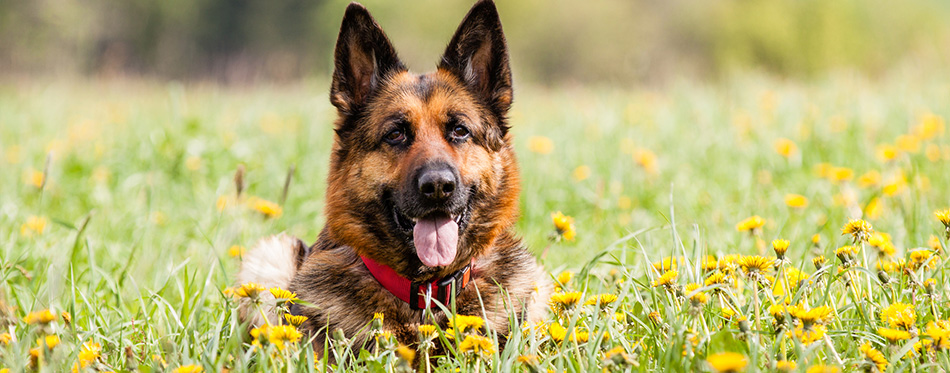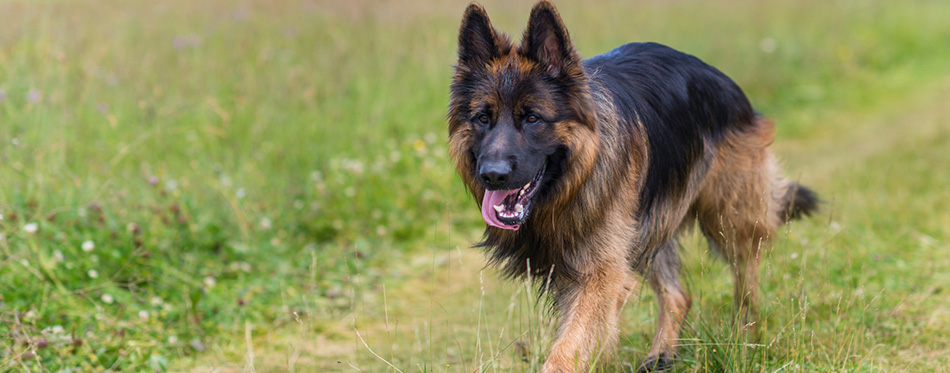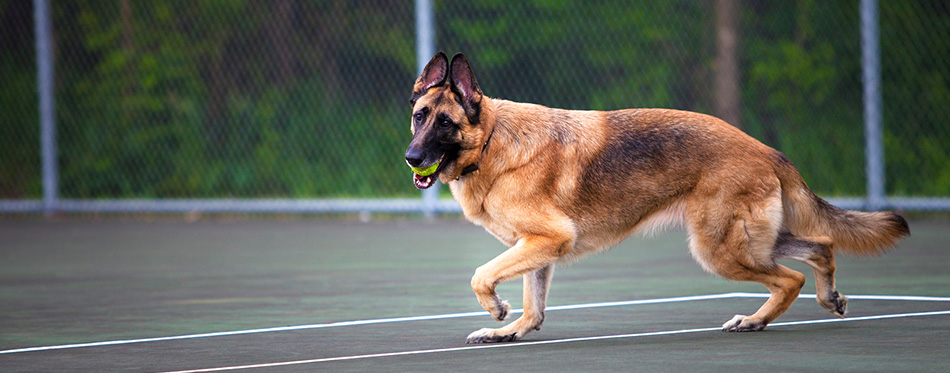It is not surprising why the German Shepherd Dog is the world’s second most popular canine breed. This is a very intelligent dog that is well-known for its unquestionable work ethic. It has the biddable nature of a Border Collie and the gentle temperament of a Labrador Retriever. Yet, when it comes to its versatility as a multi-role, multi-function, all-purpose dog, very few breeds can come close to the GSD. No one can ever deny the beauty, strength, stamina, intelligence, and loyalty of the German Shepherd Dog. Hence, it is understandable if you would also want to bring home this dog. But before you do, be sure to learn more about this faithful and o first.

History of the German Shepherd Dog
In the 1850s, German farmers and livestock owners strived to breed German Shepherd Dogs that will assist them in their work. They needed a dog that they can trust to protect their livestock from predators. They wanted a dog that was intelligent, strong, fast and has a very keen sense of smell. Unfortunately, different German communities had different dog breed characteristics. This gave birth to the formation of the Phylax Society in 1891.
The Phylax aimed to unify the breed standards that different communities adhered to in the breeding of their shepherd dogs. The intention was very novel. However, it did not last long. After only three years of existence, the Phylax Society disbanded. Members couldn’t agree on which they should focus on. One group placed emphasis on the working characteristics of the German Shepherd Dog. The other group focused more on the dog’s appearance.
Max von Stephanitz was a staunch supporter of the idea that the German Shepherd should be bred for its working characteristics. Stephanitz had a special fondness for the ability, strength, and intelligence of native sheepdogs. His only problem was that he has yet to find a dog that satisfied his strict requirements for a true German working dog.
All of that changed in 1899 when Stephanitz met Hektor Linksrhein at a dog show. Hektor was the product of selective breeding practices. It epitomized what Stephanitz believed to be the ideal traits of the perfect German working dog. Hektor was beautiful, intelligent, and loyal. Hence, Stephanitz bought Hektor from its owner right there and then. Upon purchase, Stephanitz moved to change Hektor’s name to Horand von Grafrath. Stephanitz also established the Society for the German Shepherd Dog or the Verein fur Deutsche Schaferhunde.
Horand became the mate of several female dogs that belonged to Phylax Society members from Wurttemburg, Thuringia, and Franconia. One of Horand’s puppies was Hektor von Schwaben. Stephanitz bred Hektor with one of Horand’s female puppies to produce Pilot, Beowulf, and Heinz von Starkenburg. Among these Horand grand-puppies, Beowulf was the most successful. This third-generation GSD was the father of 84 puppies, most of which were also inbred with the other puppies of Hektor. Beowulf’s progeny provided the genetic pool that further strengthened the German Shepherd as a distinct breed.
In 1906, the very first GSD – Queen of Switzerland – reached American shores. The following year, the very first GSD in the US was shown to the public in an Open Class dog show in Philadelphia and Newcastle. It would take another 5 years, in 1912, before the American Kennel Club accepted the very first GSD in its registry. In 1913, Americans fascinated with the breed established the German Shepherd Dog Club of America.
When World War I broke out, many of the GSDs employed by the German police saw action in the battlefields of Europe. The German Army used GSDs to locate wounded soldiers in the battlefield. They were also used in the handling of sensitive messages across frontlines. These dogs also served the German Army as guard dogs and watch dogs.
Many of the Allied troops who saw the GSDs in action were impressed by the remarkable abilities of the dogs. By war’s end, some of these men returned to their countries with their own German Shepherd Dogs. Many more brought with them stories of the dog’s bravery, heroism, and astonishing discipline in the face of extreme danger. These stories propelled the popularity of the dog within the following years.
By 1919, the Kennel Club of the UK began accepting registrations for the breed. There were 54 GSDs registered in that year alone. Within 7 years, the number of GSD registrants grew to more than 8,000. And with Rin Tin Tin and Strongheart featuring in Hollywood films, fondness of the breed grew stronger.
The popularity was short-lived, however. With the outbreak of World War II, Americans shunned anything that has something to do with the “enemy”. And while the GSD in the US are all born and bred in the country, they did bear the name of the “enemy”.
It took the German Shepherd several decades before it reached AKC’s third most popular breed in 1993. As of 2012, it ranks second only to the Labrador Retriever when it comes to popularity in the US. All over the world, it also ranks second when it comes to popularity. It is a title the GSD has been holding since 2013, according to the Federation Cynologique Internationale.
Quick Facts
To say that the German Shepherd is a great dog is a gross understatement. Fans of the breed can vouch for the remarkable traits of this dog. But before we take a look at some of the things all potential pet parents of the GSD has to know, let’s learn a few facts first.
- Male GSDs can grow up to 26 inches tall, with a minimum of 24 inches.
- Female GSDs are often shorter by 2 inches, ranging from 22 to 24 inches on average.
- Males tip the weighing scale at 65 to 90 lbs; their female counterparts weigh in between 50 and 70 lbs.
- On average, healthy German Shepherds can reach a ripe age of 9 to 13 years. However, it is not uncommon to hear of stories about GSDs living up to 15 years.
- Some people also call the GSD other names such as the Alsatian, Deutscher Schaferhund, Berger Allemand, and Schaferhund.
- The world’s most famous GSD, Rin Tin Tin, was a puppy that an Allied soldier found in a WWI battlefield. Rin Tin Tin is also the first canine movie star in the world.
- GSDs are very intelligent dogs. They hate being couch potatoes.
- German Shepherds always have a soft heart for young children and can be excellent family dogs.
- They are athletic, versatile, and fearless working dogs.
- GSDs are highly-trainable that they can do almost anything that you are going to train them to do.
- Some of the roles that modern GSDs take include police and military service dogs, assistance and therapy dogs, guide dogs, detector dogs, search and rescue dogs, and family guard dogs.
- German Shepherds excel in herding, tracking, rally, agility, obedience, and other canine sport.
- German Shepherds always have a double-coat with medium-length fur. People call the GSD the “German Shedder” because it sheds a lot, especially during Fall and Spring.
- The standard color of the GSD is either tan and black or red and black. There are also very rare GSD color variations like all-black, all-white, sable, silver, liver, panda, and blue. Many of these other GSD colors are sufficient grounds for disqualification in dog shows; except for all-black and sable variants.
- The body of a healthy GSD is strong and well-muscled. It features a body outline that is more curved than angled.

Things You Should Know
It should be obvious that the German Shepherd is not for everyone. There are certain traits of the dog that may prove challenging for some individuals. Here are some of the crucial points that potential GSD owners have to think about.
Training
There is good reason why the GSD is an all-purpose dog. It is an intelligent dog. Hence, it requires training right from the moment it arrives in your home. As a puppy, the GSD requires both crate training and housebreaking. This is crucial as it lays the foundation for a healthier relationship with the young GSD. Head over to our review of dog crates for more alternatives.
Being a working dog, German Shepherds are happiest when they’re given something to do. Whether it is performing basic obedience tasks to mastering agility courses, you have to prepare a training program that will last the dog’s lifetime. If you do not train the GSD, it will find other ways to utilize its intelligence and God-given gifts. This means you will be coming home to a house that’s turned inside out. Smart dogs will always try to do something to help them avoid getting bored.
Training goes hand in hand with socialization. That is why many GSD owners enroll their puppies in puppy classes. These training classes also address the issue of early socialization in dogs. One should always keep in mind that the GSD is highly protective of its people. If it senses danger or threat, it will defend its human family. Hence, early socialization is a must so that the GSD can temper its protectiveness with something more positive.
Feeding
All German Shepherds require high-quality dog food that contains high-quality animal proteins as the principal ingredient. It is best if you can provide the GSD with premium-quality raw food. If not, then you can try concocting your dog’s own food. When making the diet of a GSD, one should focus on the right proportion of proteins, fats, and carbohydrates. In general, GSDs require anywhere between 35 and 45 percent protein and 15 to 20 percent fat.
It is important to go for low-calorie diets for GSD puppies. These dogs are very prone to the development of hip dysplasia. If they grow very fast, there’s a chance that their body weight will put too much pressure on the hip joints, which can lead to a much faster deterioration of their condition. As such, giving the right amounts of food is crucial in this period in the GSD’s life.
If the GSD is given plenty of tasks to perform, it is okay to give it high-quality, moderately-high-calorie dog food. This will supply the dog with the energy that it needs to perform the tasks. However, if the German Shepherd does not have any physical activity, it is best to reduce its calorie intake. Overfeeding the GSD can lead to obesity and associated health problems.
For more guides on choosing the right dog food, you may wish to check out our reviews of the best dry dog food, organic dog food, grain free dog food, wet dog food and dog food toppers.
Grooming
The GSD may have a medium-length double-coat, but this doesn’t prevent it from shedding. As a matter of fact, the GSD also goes by another name: the German Shedder. Every fall and spring months, one can expect this dog to shed very heavily. During these times of the year, it is important to brush the GSD’s coat every single day. This will help minimize the amount of loose hairs that may find their way into your carpet and other items. At other times of the year, brushing once or two times a week is often sufficient.
If the GSD spends most days outdoors, it is crucial that you bathe it once every two weeks. Otherwise, once monthly to once every three months bathing is good enough. One should never bathe the GSD more than once every two weeks. This can strip the dog’s skin of its natural oils. It can lead to skin irritation and other skin problems. Bathing the GSD also requires the use of pet-safe dog shampoos. It is also crucial to dry the GSD’s coat very well before brushing and combing.
Part of regular grooming are cleaning the ears, trimming the nails, clipping some of the fur, and brushing the teeth. It is ideal to brush the GSD’s teeth every day. If this is not possible, then once a week or at least once every 2-3 days is enough. GSDs need to have their nails trimmed every 3-4 weeks and their ears cleaned every 1-2 weeks. One can always clip or trim the GSD’s coat once every 3-4 months.
For more help on dog grooming, you may wish to read our guides on the best dog toothpastes, dog dryers, dog clippers, dog paw washers and dog toothbrushes.
Health
While the GSD is a strong, athletic, and versatile breed, it is not a disease-free dog. German Shepherds are well-known for developing hip dysplasia. This is a condition whereby the thighbone does not fit in the hip socket in the correct manner. Because it doesn’t fit in the proper way, the tip of the thigh bone can start to wear away. This can produce arthritis in the GSD.
Another health concern among GSDs is degenerative myelopathy. In this condition, there is a very slow paralysis that develops in the dog’s hindquarters. Over time, the German Shepherd may no longer be able to move.
There are other health conditions that can shorten the life of a GSD. These can include heart diseases, epilepsy, pancreatic insufficiency, bleeding disorders, eye problems, and hemangiosarcoma, among others.

Temperament
The German Shepherd is a confident and fearless working dog. It will always protect its human family regardless of the type of danger or threat it faces. They have an easy-going nature that is quite surprising for a guard dog. They can also be affectionate with children and very approachable, too. However, when there’s a threat to its family, the GSD can show its protectiveness and strength.
The German Shepherd is always aloof and reserved towards strangers. They do not put their trust in other people that fast. As such, it will often take some time before they warm up to a new person in the household. And while GSDs are aloof, they are never aggressive. The best part of the GSD is that once it has warmed up to you, you can always rely on its loyalty throughout its life.
They are biddable pets, always willing to obey the commands of their owners. GSDs have an insatiable appetite for learning. For them, there is nothing more enjoyable than being able to learn a new trick. They need to have a purpose in their everyday existence.
German Shepherds can form very strong relationships with their human families. As such, they are also prone to bouts of separation anxiety. They hate being left alone in the house for several hours every day. One has to keep this in mind when entertaining the idea of getting a GSD for the family.
To summarize, the German Shepherd is best for the following people:
- Outdoorsy, adventurous, and physically-active types of folks
- Have advanced knowledge of dog training
- Families with kids
- Will not let the dog live outdoors
- Will not leave the dog alone for at least 6 hours at a time
- Can devote at least 1 hour every day for exercise
- Can devote at least 30 minutes every day for training
- Can brush the dog’s coat every day during heavy shedding months
Unfortunately, this dog is not suitable for the following folks:
- Couch potatoes; people leading sedentary lifestyles
- Hate grooming dogs
- Do not like the outdoors
- Will leave the dog alone for extended periods every day
- Expect a lap dog
The German Shepherd is a multi-talented dog that requires a pet parent who understands its unique needs. Make sure you understand these fundamental requirements before you try to bring one home.
Sources:
- German Shepherd Dog Facts, Pictures, & Breed Info – PetMD
- The Right Dog for the Job – HowStuffWorks

